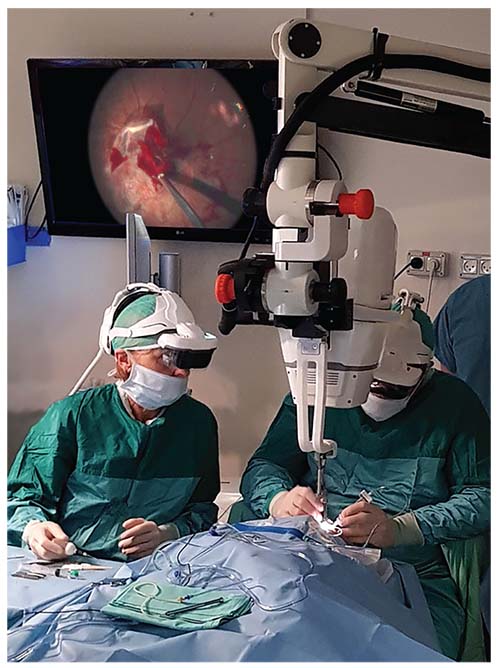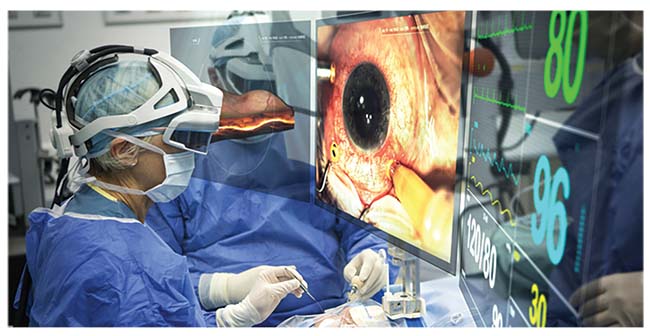Though it’s a reliable workhorse that ophthalmic surgeons have counted on for decades, the operating microscope does have some limitations in terms of the information that can be viewed in the oculars, as well as restriction of the surgeon’s movement and potential for repetitive stress injury. We’re currently working on a prototype for a head-wearable surgical display that would provide a view of the operation, as well as ancillary data, all projected onto the surgeon’s retina so it appears to be on several large screens. We’re hoping this modality will improve surgical precision and efficiency. Here’s a look at how the device works.
Functions and Features
The system is called Clarity, and it’s being developed by Beyeonics Surgical, an Israeli medical device company. Its viewing approach is actually based on technologies used in the cockpits of fighter planes.
In short, the platform serves as a digital extension of the surgeon, providing an augmented-reality view of the surgery. The components of the system and their features include the following:
• Dual 3-D, ultra HD-resolution cameras suspended on a remote arm and a transparent head-wearable display. The headset allows information to flow towards the surgeon with the simultaneous visualization of multiple fields of view (Figure 1). Using head motions, the surgeon shifts between different virtual screens projected onto his retina, and controls functions such as focus, HUD transparency, the X/Y-axes view of the image and light levels. Being able to switch the image in the display between transparent and opaque enables the surgeon to have situational awareness in the operating room, so his vision isn’t completely occluded.
 |
| Figure 1. Diabetic retinopathy case. The dual 3-D ultra resolution cameras are suspended on a remote arm. The surgeon and the assistant wear transparent head-mounted displays that allow information to flow toward them in high resolution. |
• Data from different sources in one display. The surgeon can customize the information and the user interface he sees. The technology provides a zero-lag display with no apparent image latency when he moves an instrument. Many different types of personalized, virtual information may eventually be displayed alongside the surgical image, and the company envisions Clarity eventually integrating virtual screens from external hardware such as intraoperative OCT, wide-angle lenses (BIOM), angiography, phaco settings, picture archiving and communication (PACS), and a patient’s vital signs.
• Processor. The system also contains a processing core that will allow the integration of information from multiple digital sources in real time (Figure 2), which will help with surgical decision-making.
Prototype Study
Using the early prototype version of Clarity, 40 operations were successfully performed in Israel and the United States. The procedures included vitrectomy for macular hole, retinal detachments, epiretinal membrane peeling and silicone oil removal. The surgeons used Clarity for visualization and the Alcon Constellation vitrectomy system for the surgical procedure itself.
Using the system’s head tracker, each surgeon navigated with his head between his own customized screens, and was able to achieve sharp visualization of the posterior chamber. The surgeons noted that the image quality was good, and comparable to that of a surgical microscope. The maximum magnification of the system was greater than that of a microscope.
In addition, the light levels used during the surgery were more than 50 percent less than those of the traditional microscope, which may reduce the risk of retinal phototoxicity. In some cases, surgeons activated different digital color filters on the display in order to enhance the visualization of the internal limiting membrane and scar tissue.
The head-wearable display didn’t impose any fatigue or stress on the head, and the surgeons reported that they found the use of head motions to operate the system to be intuitive.
Future Work
Though the system has useful features, there’s still room for improvement in some areas:
• The need for a wireless headset. The current head-wearable display involves a wired connection to the processor and camera, which limits a surgeon’s mobility in the operating room environment.
• An easier way to integrate applications into the digital display. Applications such as topography images, vital signs and alignment displays for toric intraocular lenses will need to be inserted into the system in an easy, straightforward manner, which is not yet the case with the device. For vitreoretinal surgeons, a very useful application will be intraoperative OCT. Offering this is a challenge, however, because when surgeons currently use iOCT systems in conjunction with a surgical microscope, there’s always the need for a technician to also be in the room to assist with the iOCT’s operation. It’s not easy to adjust on the fly or intuitive to operate for one person. In response, Beyeonics is currently working on an iOCT system that would be compatible with Clarity. To be successful, such a system will have to be very accurate and easy to operate. When these types of digital displays are available on the headset, the surgeon will be able to make the best use of the technology.
 |
| Figure 2. Using head motions, the surgeon can shift between different virtual screens projected onto his retina (simulated above), and control functions such as image focus and transparency. Integration of information from multiple digital sources in real time is also possible. |
The Clarity head-mounted display system is still in development, and Beyeonics hopes to get approval for the product in the United States in the next several months, with updated features that will allow surgeons access to more preoperative and intraoperative data during their surgeries. REVIEW
Dr. Loewenstein is director of the Ophthalmology department at Tel-Aviv Sourasky Medical Center, where Dr. Barak is head of the Retinal and Vitreous Humor Unit. Drs. Lowenstein and Barak are consultants to Beyeonics Surgical. Mr. Schneider is chief executive officer of Beyeonics Surgical.



